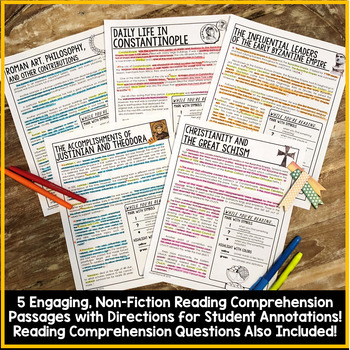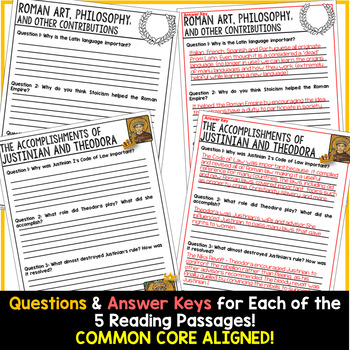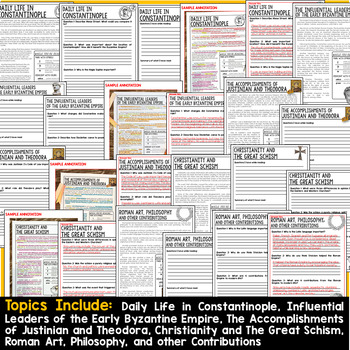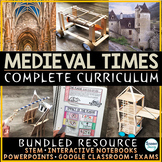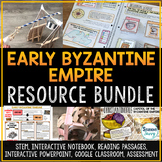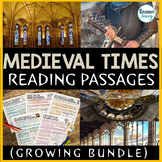Byzantine Empire Reading Passages - Questions - Activity Comprehension Notes
- PDF
What educators are saying
Also included in
- Enhance your Middle Ages curriculum with our Medieval Times and Early Modern Times Complete Curriculum Bundle, available in digital Google Classroom and PDF print formats. With over 1500 pages/slide of material, this comprehensive resource covers Early Byzantine, Early Islam, West Africa, MedievalPrice $190.00Original Price $314.93Save $124.93
- Byzantine Empire Activities Resource Bundle!This bundled product contains the following 6 StudentSavvy resources!Early Byzantine Empire Interactive NotebookEarly Byzantine Empire Reading PassagesEarly Byzantine Empire Interactive PowerPointEarly Byzantine Empire STEM ChallengesEarly Byzantine EmpirePrice $18.99Original Price $28.22Save $9.23
- Medieval Times Reading Comprehension Passages, Worksheets, Questions, and Annotations Bundle! This bundle contains 11 StudentSavvy Reading Passage Resources! 1.) Early Byzantine Reading Passages 2.) Islam – Islamic World Reading Passages 3.) West Africa Reading Passages 4.) Medieval China ReadinPrice $40.99Original Price $57.75Save $16.76
- ALL of the Reading Comprehension Passages in the StudentSavvy Store! Nonfiction **CURRENTLY 273 Passages!**-Worksheets - Reading Comprehension Passages, Questions, and Annotations--Both Print (PDF) & Digital Options (either in Google Slides or Easel by TpT) It contains Engaging, Non-Fiction ReadPrice $195.00Original Price $302.21Save $107.21
Description
Byzantine Empire Worksheets - Reading Comprehension Passages, Questions, and Annotations. This resource contains 5 Engaging, Non-Fiction Reading Comprehension Passages with Directions for Student Annotations! Reading Comprehension Questions also included!
Questions & Answer Keys for Each of the 5 Reading Passages!
COMMON CORE ALIGNED! Aligned with Early Byzantine Empire - Interactive Notebook
Quick overview of topics covered in this resource include:
1.) Daily Life in Constantinople
-Describes Constantinople as the capitol and center of trade and business
-sat at a crossroads/trade center between the Aegean Sea and Black Sea (access by seas as well as by land)
-Mese – the main street of Constantinople (comparison to New York’s Main Street)
-Hippodrome – large stadium in Constantinople that holds chariot races.
-Hagia Sophia – one of the wonders of the world in the Medieval Ages.
Keywords: Hagia Sophia, Hippodrome, Constantinople, Mese
2.) The Influential Leaders of the Early Byzantine Empire
-Describes the major accomplishments and major events of influential leaders during Early Byzantine Empire (introductory paragraph + a paragraph on each ruler)
-Emperor Diocletian (in power during 284-305AD) -splitting the Roman Empire into Eastern and Western
-Emperor Constantine (in power during 312-337AD) The first Roman emperor, built Constantinople
-Emperor Justinian (527-565AD) – the Justinian Code of Law and the Golden Age of Byzantium.
-Empress Theodora (527-548AD) – advocated for the rights of women and children, ruled alongside Justinian. She helped assist him to end the riots in Constantinople
Keywords: Byzantine Empire, Emperor
3.) The Accomplishments of Justinian and Theodora
-Describes their upbringing (Justinian born a peasant and son of a farmer – Theodora was an actress and they fell in love)
-Describes The Justinian Code – a collection of laws, made up of four books of laws.
-Describes how Theodora helped end the riots in Constantinople (Nika Revolt)
-Theodora created laws that would empower and protect women
Keywords: Justinian Code
4.) Christianity and The Great Schism
-Describes how the Eastern and Western Churches split apart after The Great Schism -the Western Roman Catholic Church, the pope claimed authority over everyone, including emperors and kings. In the East, the emperor still rules over the patriarch and is the leader of the church.
-Compares and contrasts the similarities and differences of the West Roman Catholic Church and the Eastern Orthodox Church (mention the use of icons and how Leo III banned them from the church)
Keywords: Roman Catholic, Pope, Icons, Schism, Orthodox
5.) Roman Art, Philosophy, and Other Contributions
-Brief overview of contributions (art, philosophy, aqueducts, roads, etc)
-Describes Mosaic art – how it was popular and used in churches and other important buildings – a sign of wealth and importance.
-Describes Stoicism and philosophy during this time. Important concepts of duty and virtue. The idea of playing an active role in society and how it helped strengthen Rome at the time.
Keywords: mosaic, Stoicism
You may also enjoy:
Medieval Times (Entire) Curriculum
Ancient Civilizations (Entire) Curriculum
Medieval Times Interactive Notebook Bundle
Medieval Times STEM Challenges
Byzantine Empire STEM Challenges
Byzantine Empire Interactive Notebook
West Africa Interactive Notebook
__________________________________________________________________
Tips for Savvy TpT Shoppers:
How to receive credit on TpT to use for future purchases:
• Go to your My Purchases page. Under each purchase you'll see a Provide Feedback button. Simply click it and you will be taken to a page where you can give a quick rating and leave a short comment for the product. I value your feedback greatly as it helps me determine which products are most valuable for your classroom so I can create more for you.
Be the first to know about my new discounts, FREEBIES, and products:
• Look for a green star near the top of any page within my store and click it to become a follower. You will now be able to see FREEBIES and customized emails from my store!
©2018StudentSavvy
All rights reserved by author. Permission to copy for single classroom use only. Electronic distribution limited to single classroom use only. (unless you purchase the multiple license)
____________________________________________________________


